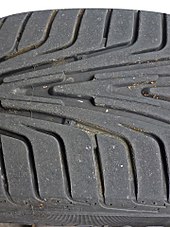Tire wear indicator
At the treadwear rating (Wear indicator Tread Wear indicator, TWI) to detect whether a tire is worn, ie the profile is not of the tire more the minimum tread depth has. For this purpose, there are small ridges, mostly across the direction of travel, in the grooves of the main profile. To make these easier to find, the letters TWI are usually printed in the appropriate places on the edge of the tire . When the tire is so worn that the indicator is level with the tread, the tire must be replaced.
The legally prescribed minimum tread depth in Germany is usually 1.6 mm. However, the indicator does not necessarily show the regionally legally prescribed value, but also more, depending on the manufacturer, in order to persuade the consumer not to buy new tires only when the minimum tread depth is reached (on the other hand, experts on many sides criticized it as too small).
With motorcycle tires it should be noted that TWIs often indicate a minimum tread depth of only 0.8 mm, which is only relevant for the North American market. In practice, the TWI is therefore unsuitable for monitoring the residual profile depth in regions with deviating legal minimum requirements (e.g. Europe with mostly 1.6 mm residual profile depth) and does not replace regular testing with the vernier caliper or another suitable measuring device.
See also
Individual evidence
- ↑ ADAC car tire labeling as of 07-2017 p. 8 (PDF file; 836 kB)
- ^ Homepage of Metzeler, Section Driving Safety - Minimum Profile , accessed on May 1, 2016

